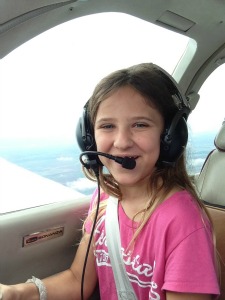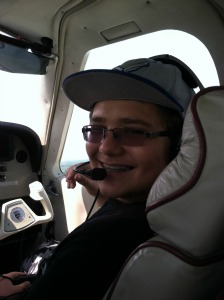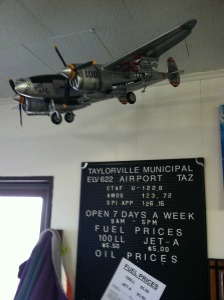Eager Eagles
The Bonanza could only take three passengers at a time, so the kids discussed who would go first with all the seriousness of the U.N. debating a resolution
![]()
Once a month, scrambled eggs, strong coffee and fellowship combine in a crowded hangar in Taylorville, Illinois at the Experimental Aircraft Association (EAA) Chapter 1315′s regular pancake breakfast. Recently we stopped by Taylorville Municipal Airport while visiting my in-laws Vito and Mary, who live in nearby Springfield. Taylorville (KTAZ) has two paved runways — the longest a bit over 4,000 feet — and a grass strip beloved by its local pilots. Its operations office features glass cases filled with die-cast models donated by John McClure, and the hangar outside is crammed with three wingless Learjets. Wooden racks house cowlings and other spare parts.
As we cleaned our styrofoam plates on long folding tables, my brother-in-law, Brian Prinzavalli — who’s an enthusiastic pilot in two Las Vegas-area EAA chapters — and Larry Snyder chatted next to the hangar doors. A handful of kids, mine included, had been eyeing the sky and watching the occasional airplane taxi up for fuel, and it didn’t take much to convince Snyder to bring his Beechcraft A36 Bonanza out of its hangar for an impromptu “Young Eagles” event.
He could take three passengers at a time, so the kids discussed who would go first, and with which fellow traveler, with all the seriousness of the U.N. debating a resolution. Who would sit up front? Should the girls, including cousins Olivia and Chloe, go together, or should sister and brother? But what if that bumped a BFF?
Ultimately, it was decided. The two boys would fly first, so I walked my son Ian and his cousin Tommy to the Beech. Ian took the right seat and Tommy sat facing aft. Jerking a thumb at the extra seat, Snyder invited me aboard, and within a minute, the door thunked closed and we were holding short to Runway 18 while he ran up the engine and checked the magnetos. No intricate ballet of overhead bin stuffing, safety briefings from the flight attendant, or endless taxiing. Flying at Taylorville means you just throw on a headset and go — and we were definitely number one for take off.
The bumpy Midwestern air became smooth at about 2,200 feet as we climbed above a thin layer of clouds. Grain silos, the concrete ribbon of Highway 29 and the neighboring town of Edinburgh passed sedately below. Snyder told Ian to grasp the yoke. After a few calmly delivered instructions, Snyder’s hands were off the controls and it was Ian’s airplane. For the next 10 minutes, I craned my neck forward and watched my 12-year-old son execute five gentle turns to bring us downwind and back to the airport, all the while scanning for traffic like a pro.
Three girls went next, and Eve, my daughter, took right seat. After the Beech returned to Earth with a tire chirp, I could see her bouncing up and down in her seat from excitement as they came off the runway. She too, got some good stick time, and Snyder handed me his phone so I could send myself a photo of a beaming and confident 9-year-old girl (wasn’t she just using sippy cups?) piloting a Bonanza.
Since 1992, the EAA has flown more than 1.6 million kids through its Young Eagle program, which is aimed at exciting a new generation of kids about careers in aviation, or simply enjoying the freedom of a private license.
I know two kids who just got hooked.
/https://tf-cmsv2-smithsonianmag-media.s3.amazonaws.com/accounts/headshot/Sotham_photo.jpg)



/https://tf-cmsv2-smithsonianmag-media.s3.amazonaws.com/accounts/headshot/Sotham_photo.jpg)